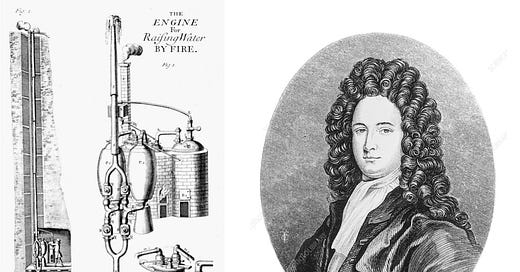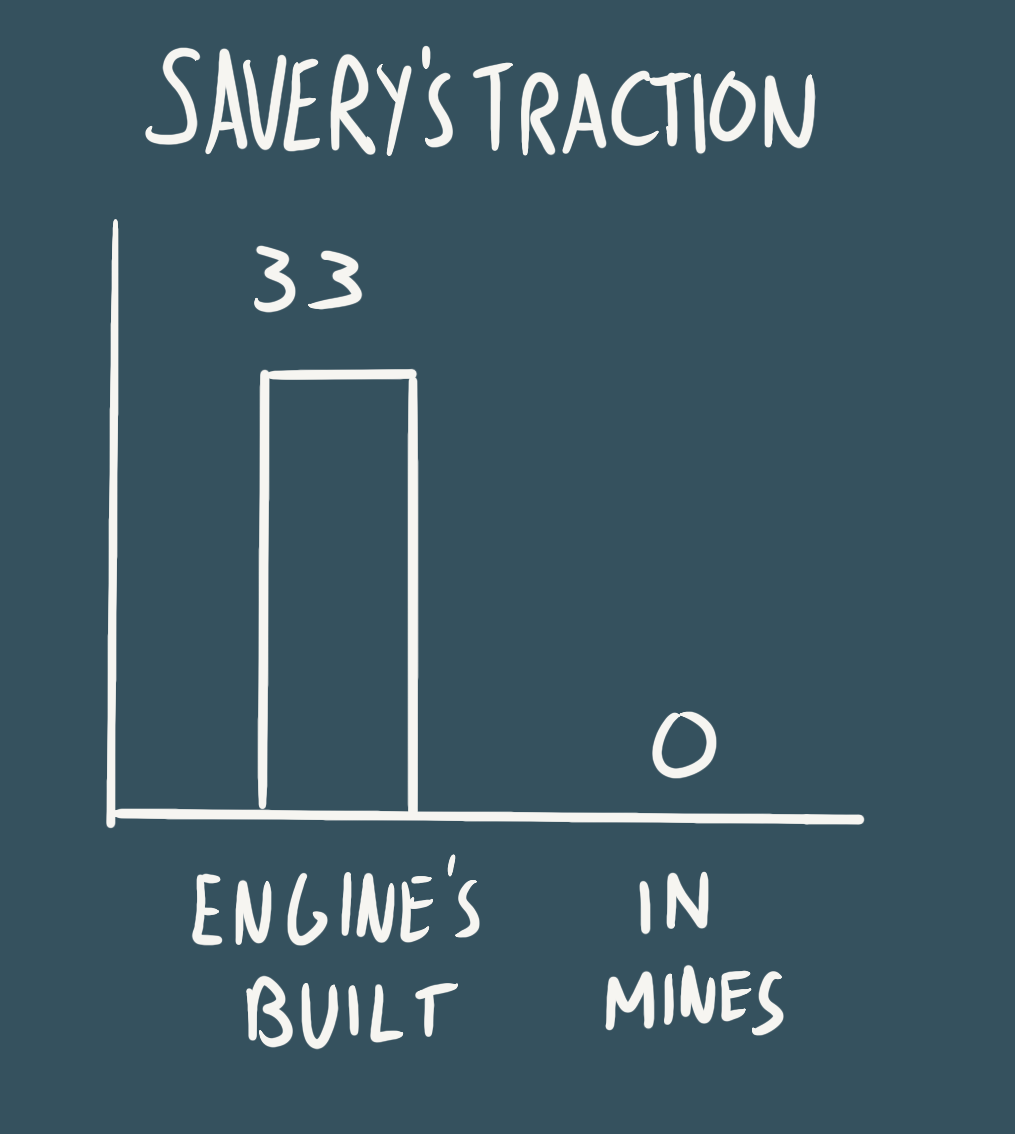📈 MAGIC 1000 SUBSCRIBER MILESTONE REACHED 🚀
Welcome all new 83 subscribers, total subs 1074 :)
Beachhead market series
📰 What makes a great beachhead market?
📰 Five expansion strategies from your beachhead market
📰 How to validate your beachhead market with experiments?
➡️ Today: From beachhead to product-market fit: lessons from the steam engine
The last part of our series on beachhead markets. Oh yeah, this is one of those super historic pieces of Jeroen. I love it. It’s a long read, about 15 minutes. Maybe listen this time? On Spotify?
How the steam engine got product-market fit
People always needed moving things. Moving wood around, rising up water, ploughing fields, you name it.
In 1700, people and animals created 99% of all that kinetic power. 200 years later, 50% of that power was generated by steam. Even though the steam engine changed the world for good, it wasn’t a home run from the start.
This is the story of how one inventor got some traction but missed product-market fit and how a second inventor got product-market fit.
Sections
The invention of the steam engine
The ideal market: mines
First attempt: 33 machines built
Second attempt: 1000+ machines built
Who earned the most money?
Lessons on product-market fit
1. The invention of the steam engine.
Of course, the Greeks did it first. The idea of steam-propelled kinetic energy is about 2000 years old. An aeolipile, also known as Hero’s engine, was a toy of around 25 BC.
Fire would heat up the water, and create steam. That steam would rise upward via pipes into a ball. Because the ball had two exits, the steam could exit and generate motion.
It had no particular function other than being a cool party trick. Even though Hero’s engine demonstrates potential, it remained a party trick for 1700 years.
The first invention we call a steam engine
In 1698, Thomas Savery invented the first steam-powered water pump. It’s not really an engine, as there were no moving parts except for the valves.
He used the fact that water expands when heated and contracts when cooled. This generates pressure differences. These pressure differences could pump up water.
Savery had this amazing new technology and got a patent. Simply put: use fire, get force to pomp or generate motion. Quite a broad patent, which will serve handy later.
2. The ideal beachhead market: mines
Now with his contraption legally protected, at least in the UK, Thomas Savery could embark on capitalising on the invention. He had many ideas for beachhead markets, such as in mills, water supply companies, and mines. And mines was the true prize.
What made mining such an interesting market?
Around 1700, many industries such as metalworking grew and by that, the demand of fuel grew. Wood and coal were vastly popular as fuel sources.
A. Lot of capital in mines
However, wood got scarcer as England literally was cutting themselves clean of trees. In 1400, 10% of land in England was trees, whereas in 1900 it was 5%.
This raised the price of wood over in a short period 1000%. Importing wood from Norway was an alternative, but an expensive one. In that same period, the price of coal rose 800%.
However, coal has a much better energy density, it packs three times as much energy per kg than wood. Coal became the new gold. For that, there was a lot of capital in the mining industry.
B. Big problem: water in your mines
What can a steam engine do in a coal mine? It can pump water. This is something I didn’t understand the first time I read about steam engines.
To keep up with the increasing demand of coal, deeper and deeper the miners dug into the mines. What happens if you dig deeper? You will hit water reservoirs. The moment you hit such a water reservoir, your mine overflows.
And then you are stuck with a problem: You need to drain that mine, as soon as possible. Every second you are drained, you are not mining. A big problem, as this standstill is costly.
C. Inferior alternatives
Mining is quite an old activity. There are mines (let it be a different form) that have been found around the agricultural revolution, that is 10.000 BC. How did people dewater mines before the steam engine?
Sometimes they used a bucket hoisting system, an Archimedes screw, or wooden mechanical pumps, sometimes powered by horses or a water wheel using a nearby stream.

What most alternatives had in common is that they require manpower or horsepower. This hindered the speed at which a mine could be dewatered and created uncertainty in downtimes.
Water wheels could generate this force, but this could only generate power if there happened to be a water stream nearby. Savery knew this and saw an opportunity for his steam engine.
3. First attempt: Lack of product-market fit in mines
Traction: 33 machines built
How many steam engines did Savery build? 33. They were installed where water pumping was required. We can find sources mentioning water supply or in mills. There’s mention of Czar Peter 1 having one installed in his garden for his well. They could work quite well, one Savery engine installed at the water supply worked for over 18 years.

What about the prize, the mines? Very few, some sources mention zero, Savery engines have been installed in mines. James Watt’s autobiography mentions only 1 Savery engine was ever installed. So sassy.
Obstacle: Savery’s machine was not superior
Zero mines. Why? Mines as a business case seemed so good. Well, it was. But for that to work one needed a superior machine. And Savery’s machine wasn’t.
The severe pressure on the vessel caused the welds burst. Explosions were not uncommon.
Savery’s engine could only pump water up to around 6m-10m. Some mines were already 100 meters deep in 1700. This is listed as a key problem that hindered adoption.
Savery’s engine was extremely inefficient. It was not profitable to use
The limitations of Savery’s machine could not be circumvented. One could install 10 Savery engines to get to 100 meters, but is that profitable? Turns out, most people said no.
A market can be very tempting, but if you don’t have the product to serve it, that market is not yours to capture.
4: Second attempt: Getting product-market fit with a better product
Savery’s engine was a feat of engineering that got some traction. There clearly were some tech enthusiasts and innovators that experimented with the engine. However, it was not good enough to capture the mining market.
For many historians, Savery’s engine is merely a stepping stone for the development of a steam engine that got much wider adoption. There were three issues to be fixed:
Explosion risk
Pumping power
Inefficiency
Requirement: A superior machine
Meet Thomas Newcomen. An ironmonger that builds on Savery’s design. He replaced that exploding vessel with a cylinder, among other things. The use of the cylinder was very important. It could withstand much greater pressures. Explosion risk averted.

Why didn’t Savery think of this? The creation of cylinders that could withstand such pressure was a speciality. Newcomen was an ironmonger that I assume knew a lot about this.
In the 18th century, when building Newcomen engines, cylinders would be one of the parts that would not be skimped on, and sometimes transported from specialists on other sides of the country.
The cylinder was one of many improvements. The increase potential pressure resulted in an engine that was able to pump much deeper without the explosive risk.
Requirement: viable
Coal was the new gold and was expensive as a fuel. Newcomen’s machine still was inefficient: the first version converted less than 1% to power.
However, where is coal the cheapest? At its source. Even though it was inefficient, it was efficient enough. Historians believe that this allowed Newcomen’s inefficient engine to flourish.
Traction: 1000 engines built in 18th century
In the first 20 years, about Newcomen 100 engines were built, a colossal business achievement for the time. By the end of the 18th century, over 1000 Newcomen engines were built on the British Isle. Almost 50% of all steam engines built in the 18th century were the Newcomen design.
About half of all steam engines in the 18th century were used for mining purposes, and Newcomen’s were happily adopted in that market.
Newcomen hit the mainstream mine market, whereas Savery hit some other markets and didn’t grow futher. Even though Savery was the first, Newcomen’s engine fully captured that market.
5. Who earned the most money?
Newcomen’s engine was superior and got the traction Savery actually hoped for. However, Newcomen had an issue: he worked on the patent of Savery. That patent was quite broad:
“[..] a new invention [..] for raising of water, and occasioning motion to all sorts of mill works, by the important force of fire”
That patent was so broad, it basically granted Savery a monopoly on steam engines. It is generally seen that Newcomen himself didn’t earn a lot on his invention, as the royalties to Savery were very high. Savery seems to be the winner here.
Did Savery switch his business model from an engineering company to a licensing business? I couldn’t find precise evidence of this. However, with Newcomen’s engine taking off, and Savery having this broad patent, it might give him less incentive to improve his machine.
6. Lessons on product-market fit
Newcomen machines clearly got better traction, also in the mines. What can we learn from this story about product-market fit?
What is the job to be done of your beachhead market?
Savery seemed to assume his machine was good enough for mines. Pumping depth was a dealbreaker, a functional job to be done. Your product needs to complete that job.
What are the criteria of your beachhead market?
Against what does your target beachhead market measure the impact of that job? In this case, it was explosion risk and viability. Even when Newcomen’s engine would pump deeper, if it was not a viable option, I assume it wouldn’t have got the traction it got.
Traction is good, increasing traction is better
Savery stopped at 33 machines. Not everything sells itself. However, it could be that Newcomen’s traction in 1712-1732 removed the incentive for Savery to innovate. He had the patent, after all. Don’t sit there waiting: if you build it, they won’t come.
Your business model defines how you measure product-market fit
Savery’s product? Meh. Savery’s license? Hell yeah. Which product are you measuring against what market? The licensing business of Savery was very successful. Everyone that was building Newcomen steam engines needed to pay royalties to Savery.
You don’t know what you don’t know
Your product’s limitations might need knowledge not available to you. Inviting others to innovate with you can help. This can be in identifying limitations and solving them.
Support my writing
Do you enjoy my writing? I spend about 20 hours per article on average. Showing your support keeps me motivated.
No money? Here, put in a vote
This article was Great - Good - Meh
Need help in getting product-market fit?
I mentor early-stage startups to product-market fit. Do you have some traction, but not enough? Perfect.




















Share this post